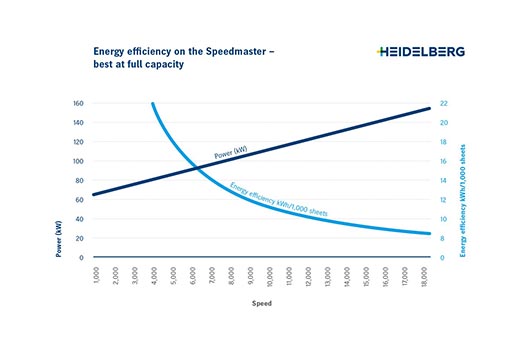More Sustainability in the Printing Process – HEIDELBERG Turns Print Shops into Pioneers of Energy-Efficient Production
Press release from the issuing company

A printing press is at its most energy-efficient when running at full capacity, as this ensures its basic energy requirement is spread out over more printed sheets.
- Company launches energy efficiency campaign for print shops
- Using state-of-the-art HEIDELBERG equipment clearly exceeds 1997 Kyoto Protocol targets
- Energy consumption of latest Speedmaster XL 106 generation around 40 percent lower than that of a press from 1990
Back in 1997, the Kyoto Protocol stipulated that, by 2020, industrial processes should be at least 20 percent more efficient than they were in 1990. Today, due to the general trend for more sustainability across the whole of society, ambitious climate protection targets, and the present energy crisis, there is growing pressure on the print media industry to make the entire production process even more energy-efficient – and to do so quickly.
Heidelberger Druckmaschinen AG (HEIDELBERG) has therefore launched a campaign for print shops featuring information, advice, and tips from experts on how to considerably increase energy efficiency in printing companies while simultaneously driving down costs. The company will be focusing on several headline issues in its communications over the next few months.
“The subject of sustainability and energy efficiency has become a crucial competitive and cost factor for suppliers in the print media industry – and that applies equally to our customers and to HEIDELBERG itself,” says Dr. Ludwin Monz, CEO of HEIDELBERG. “Alongside its customers, HEIDELBERG aims to extend its leading role in the industry to include energy efficiency as well. Due to our technological and data expertise, we are able to offer our customers attractive options for achieving energy-efficient production and can provide comprehensive advice and consulting. We all need to work on these issues if we are to hit climate protection targets.”
Speedmaster XL 106 – energy efficiency as standard
To launch the campaign, HEIDELBERG is showcasing the energy efficiency of the Speedmaster XL 106. For example, a comparison between the Speedmaster CD 102-6+L from 1990 and the current Speedmaster XL 106-6+L reveals that energy consumption per 1,000 sheets has been reduced from 13.8 kWh to 8 kWh – a reduction of 40 percent. A whole range of innovations and improvements throughoutthe entire system is responsible for this achievement.
Besides investing in cutting-edge equipment, print shops can also further boost their energy efficiency by optimizing the way they use their equipment. This is where one principle in particular comes into play – one that highlights a key difference between printing presses and automobiles, for instance, which consume more energy the faster they travel. By contrast, a printing press has a basic level of energy consumption that covers the fundamental operating functions. Beyond this, energy consumption increases in line with rising printing speed, but since the basic level of energy consumption is spread over more printed sheets, overall energy efficiency improves. This means a press is at its most efficient when a job is being printed at full speed – ideally on a fully automated basis – and when, after that job, the system either moves on immediately to the next job or switches to standby mode if there is nothing else to be printed.
“When it comes to energy efficiency in print shops, although the equipment being used is an important basis, operating that equipment in the best way possible is at least equally as important. This is often where companies can really make a big difference. It is at precisely this point that the HEIDELBERG campaign for greater energy efficiency comes in and creates a basis for fully utilizing pre-existing potential,” says Dr. Eva Boll, head of ESG at HEIDELBERG.
Speedmaster XL 106 with energy measuring device
Starting April 2023, the Speedmaster XL 106 will be supplied with an energy measuring device as standard, albeit only in Germany initially. This will enable users to permanently monitor the energy consumption of their press – measured in kilowatt-hours per 1,000 sheets – from the control station. This read-out encourages operators to run the press in an energy-efficient way – in other words, at maximum speed. All in all, various energy-efficiency measures also help print shops reduce the CO2 emissions associated with their industrial processes.
The second theme of the campaign highlights the potential in terms of savings offered by peripheral units for the Speedmaster, which makes energy-efficient production possible. Next, the campaign addresses the issue of “maintenance”, revealing the extent to which regularly maintained machine systems can conserve resources and improve the energy balance. To complement the campaign, HEIDELBERG offers relevant consulting services so it can work with customers to identify potential for energy savings in the print shop and draw up plans for leveraging that potential.
© 2025 WhatTheyThink. All Rights Reserved.













